Prices and Availability Subject to Change. Please call 800-997-4311 for more Information.

1870s Men's Clothing Guide
The 1870s began the Gilded Age, a period of American industrial and economic growth surpassing Britain's. The completion of the transcontinental railroad in 1869 enabled people and goods to cross the country in 6 days rather than 6 months. The telephone, phonograph and incandescent light bulb were patented, and the rise of new industries changed the face of the country, as well as the fashion worn by men and women.
Wide availability of the sewing machine, American made fabric, improvements in transportation, and standardized sizing allowed garment patterns and ready-to-wear garments to be available to almost anyone anywhere via mail order catalogs, and a man's complete wardrobe could be bought readymade, in good quality, without the need for a tailor.
The primary change in attire was a narrowing of the silhouette. Gone were the days of the large ties and colorful vests of the 1860s. Instead the decade was characterized by a blend of elegance, sobriety, and practicality. A tailoring trade journal noted in 1871, that men dressed "as quietly as it is possible to do," avoiding extremes in dress.

Complete Mens 1870s Outfits
At Historical Emporium, we offer a full line of men's period clothing which are suitable for movie and TV production, theatrical, living history and performing arts requirements, and are also perfect for vintage weddings!
All of the products we sell are sold individually, but we have put together a selection of full outfits to showcase the elements of 1870s mens style for your consideration and inspiration.
To learn more about individual elements of 1870s mens style, read on!
Frock Coats


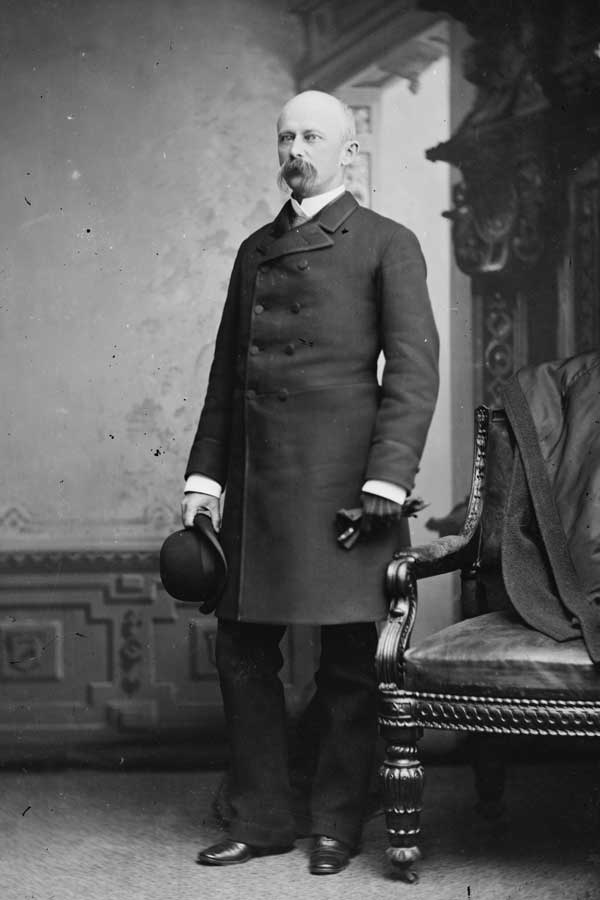
The frock coat remained a staple of formal daywear, evolving to a slimmer fit with narrower sleeves and lapels, reflecting the period's trend towards more understated elegance.
There was a brief trend for very short frock coats, with hemlines ending well above the knee, but the longer frock coat quickly regained supremacy. Both single and double breasted frock coats were seen throughout the decade. When wearing single breasted coats, some gentlemen would fasten only the top button of their coat to allow their vest and pocket watch chain to be on full display.

Cutaway Coats
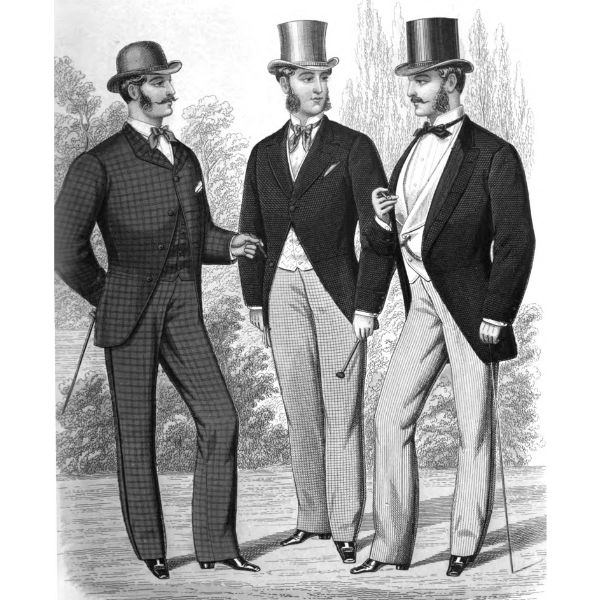
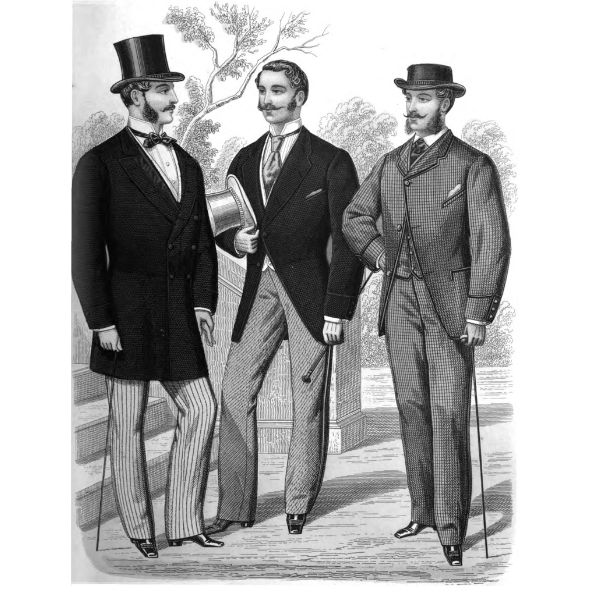
Cutaways (or "morning coats") first appeared in the 1850s and had evolved from the "Newmarket" english riding coat. The cutaway style gained popularity in this decade by offering a stylish yet less formal alternative for daywear. With its distinctive cutaway opening and waist seam, its gave freedom of movement and a sleeker silhouette.
Like the Frock Coat, the Cutaway could be single or double breasted and was made of dark wools with silk braid for formal wear. For more casual daywear and sporting events tweeds and linens were the fabric of choice.
Also like the Frock Coat, the Cutaway could be single or double breasted and was made of dark wools with silk braid for formal wear. For more casual daywear and sporting events tweeds and linens were the fabric of choice.

Sack Coats
The shorter, less structured, Sack Coat continued to be popular for informal occasions, and was often worn with just the top button closed to reveal the gentleman's vest and watch chain. The coat was most easily distinguished by its lack of a waist seam and shorter length. It often formed part of a coordinated suit that foreshadowed the modern three-piece suit.
Though black reigned supreme, sack coats were often available in a variety of fabrics and colors, including plaids, checks and tweed.

Overcoats and Cloaks
Overcoats (or "top frocks") worn in this decade included the Chesterfield, the Inverness, and the Ulster, the latter two often featuring capes (as sported by Sherlock Holmes in illustrations.)
These coats were often knee length throughout the decade, and primarily made in wool.

Smoking Jackets and Robes
The smoking jacket was a popular casual jacket for wearing at home. Also called a "breakfast jacket," it could be luxurious in velvet or quilted silk with contrasting lining, or made more simply from contrasting colors of flannel.
Often designed with braid trim and frog closures, a tailoring journal referred to the smoking jacket as being "among the minor comforts of a gentleman."


Trousers
Men's trousers in the 1870s were typically made from wool or linen and featured a high waist with a straight and somewhat narrow leg, compared to the baggy trousers popular in the late 1850s and early 1860s. Trousers were held up by suspenders, as belt loops were not yet common. Striped or checked patterns were popular for casual wear, while more sober solids or barely-there stripes were reserved for more formal contexts.
Of note, in 1873 Levi Strauss and Jacob Davis introduced the original copper riveted denim jean to meet the demand for durable workwear. The unique copper riveting system was patented and became an iconic piece of fashion history.
Vests
Commonly called waistcoats, the vest remained a staple of the male wardrobe for all classes - shirts were essentially considered undergarments and a gentleman dared not be seen in "bare shirtsleeves" by anyone other than his wife or close family.

As the neckline of men's coats rose higher through the decade, it became more common for vests to match the dark color of the coat, although men of affluence and bon vivants would often still don colorful silk, brocade and embroidered vests.
Despite the focus on somber tones, vests were seen in single and double breasted cuts with a wide variety of lapel, button and collar styles. Collars included notch and shawl collars, as well as the increasingly popular collarless style.

Shirts
Shirts reflect the same trend as coats and vests, becoming plainer throughout the decade, although stripes and plaids of blue, red or gray on white are still seen.
Unlike modern shirts, the 1870s gentleman had shirts made without collars or cuffs. Collars and cuffs could be washed and starched separately from the shirt, reducing laundry requirements while still maintaining a crisp, clean look. According to clothing guides of the time, a gentleman would have 6 or so sets of each.
While high stand and wingtip collars maintained their popularity for day and evening wear, fold down collars continued to make headway in daywear.


Neckties
Neckwear of all kinds could be seen throughout the decade.
Small, soft bow ties were a common sight, as well as cravats.
As the decade progressed, the "four-in-hand" and ascot both gained popularity. The four-in hand featured very large knots, and was seen in solid colors as well as stripes and polka dots.
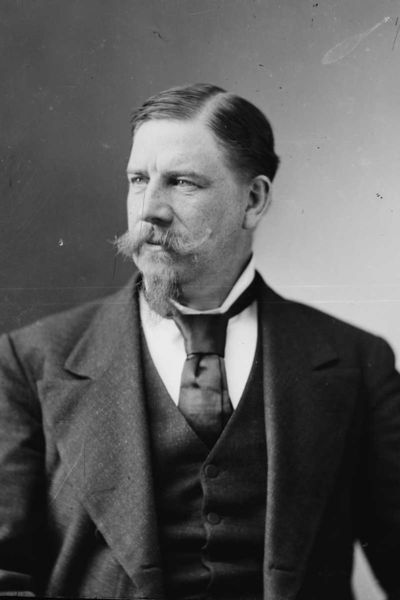

Hats
Tall black top hats continue to be required for formal daywear and evening occasions, worn with frock coats, fancier morning coats and evening tailcoats, but were seen less often for daywear than in previous decades.
In place of the top hat, the derby/bowler hat became the fashionable and more youthful choice for pairing with a cutaway or sack suit in the 1870s. Derbies were available in various heights and colors, as were a variety of other styles for work and play.
Wide brimmed hats with lower crowns were also available in a variety of colors and styles, of made of felt or straw.


Hairstyles and Accessories
The 1870s saw shorter hair for most men. It was often side parted and slicked down, a considerable change from the longer curled sides and top of the previous decade. Facial hair took center stage and men embraced a variety of styles including full mutton-chop whiskers, handlebar mustaches, full beards and goatees.
The pocket watch and its visible chain continued to be a common accessory for men of every station.
Evening Wear
Black tailcoats remained the standard for formal and evening wear. Most often worn with a matching waistcoat, white shirt with a pleated or frilled chest inset, and dark silk bow tie. Matching trousers, often with braid on side seams was also quite common. A silk top hat, especially the Gibus collapsible opera top hat was a popular choice for evening events.

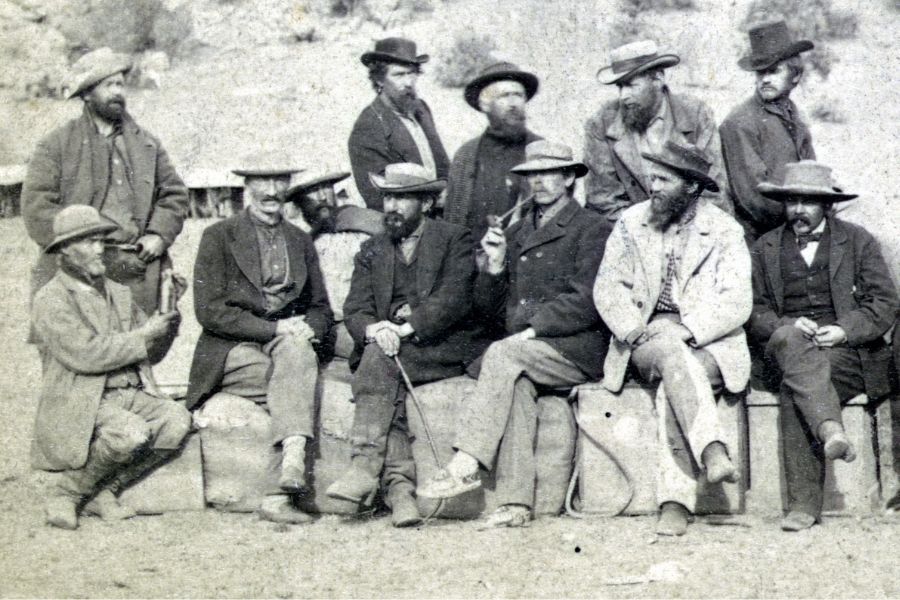

Work Wear, Frontier & Cowboy Clothing
As is ever the case, fashion trends are for the wealthy, and men in the working and lower classes got by with the clothing they had for as long as possible. In fact, most clothing was reused for other purposes when it wore out. A dress could be cut down to create shirts for the children, or a worn-out coat could be recut for another family member.
As photographic technologies progress throughout the 1800s, our understanding of styles worn by the average citizen becomes clearer. In occupational photos from the 1870s as well as group photos, we see how styles were blended.

A butcher wearing a casual thermal top and apron with a very tall, shiny top hat, or a group of painters wearing vests with lapels, no lapels, ties, no ties, stripe shirts, plain shirts and hats or caps.
Candid photos and occupational portraits are a great resource, and show how men mixed styles for their personal needs.
Location, occupation and personal taste resulted in outdated, anachronistic clothing combinations not seen in fashion plates or tailor's journals.




